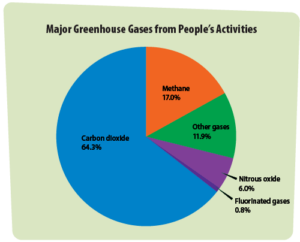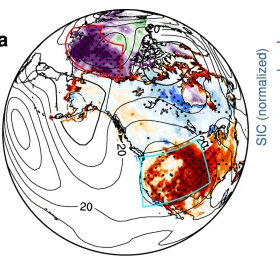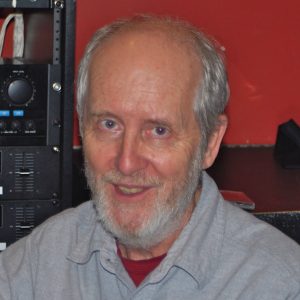Take a break from the pandemic. Earth is calling. The 3rd major global warming gas, nitrous oxide, is emerging from permafrost, another feedback. From Finland, we hear from lead author Dr. Maija Marushchak. Then another shock: new science connects disappearing sea ice to more wildfires in the western U. S. That is big news from Dr. Yufei Zou in our second interview. Welcome back to Radio Ecoshock.
Listen to or download this Radio Ecoshock show in CD Quality (57 MB) or Lo-Fi (16 MB)
MAIJA MARUSHCHAK – THAT THIRD BIG WARMING GAS
– NOW EMERGING FROM THE ARCTIC
This story of nitrous oxide coming from far north landscapes we never see is a million miles out of public radar. We literally don’t see it coming. Yet another dangerous global warming feedback has been uncovered in the Arctic. It is nitrous oxide, the greenhouse gas that doesn’t get enough respect. Yes, the major driver of climate change is carbon dioxide, as 63% of human-induced emissions. Methane is next at 17%. Nitrous oxide, more powerful but rarer, lags behind counting only 6% of greenhouse gases from people’s activities. [EPA GUIDE]
Two things: with our future climate on a knife-edge, that 6% could tip us into changes difficult to survive. And, like carbon dioxide and methane, nitrous oxide emissions are rising steeply in the atmosphere since the industrial revolution and accelerating. Six percent of a rapidly growing total burden becomes a larger and larger amount.
So what is nitrous oxide? It is a gas where two nitrogen atoms are bound tightly with one oxygen atom. For humans, nitrous oxide is used in dentistry as a pain reliever and for sedation. It is an asphyxiant. Strangely, nitrous oxide also triggers the laugh reflex, it is “laughing gas”. It was discovered in 1799 by a 20-year-old chemist Humphry Davy – immediately tried out by friends for a giggle. In the 1800’s, traveling medicine shows and auditoriums blasted people with nitrous oxide to create uproarious crowds. It still returns periodically as a hip party thing, but remember nitrous oxide is a dangerous asphyxiant that can be lethal.
One other thing: according to Wikipedia: “A 2009 study suggested that N2O emission was the single most important ozone-depleting emission and it was expected to remain the largest throughout the 21st century.” So it is not a good thing to have more of it.
The basic element nitrogen is cycled through soil, plants, and our bodies, and back into the atmosphere. The process of nitrogen being captured by micro-organisms is called nitrification. When it becomes a gas again, that is denitrification, where it unites with oxygen, escaping as the potent greenhouse gas nitrous oxide.
Here is the new wrinkle: until recently, science agreed the big plays in the nitrogen cycle are in the Tropics. The Arctic has lot of nitrogen in frozen soils, but the micro-organisms to free are not there. Thank goodness. But new science finds with a warming Arctic, and thawing permafrost, serous nitrous oxide emissions are starting up. That means humans can emit even fewer greenhouse gases before we lose our livable planet. So let’s get to that new science.
INTRODUCING MAIJA MARUSHCHAK, FINLAND
You hear about carbon dioxide and methane flowing into the atmosphere as permafrost thaws. But there is more: nitrous oxide, the greenhouse gas we never hear about. It is pound for pound 300 times more powerful for warming than carbon dioxide. Nitrous oxide stays in the atmosphere for 114 years.

Source: EPA
Humans induce about 43% of nitrous oxide gas reaching the atmosphere. The rest is “natural” so-to-speak. But nitrous oxide from natural sources is getting a boost as the northern top of the planet thaws. New science published December 2021 in the journal Nature, explores vast lands where powerful greenhouse gases emerge in a positive climate feedback.
Dr. Maija Marushchak is a Postdoctoral Researcher at the University of Jyväskylä, Finland. She authored and co-authored dozens of works on the Arctic, from tundra soil to atmospheric gases.

Dr, Maija Marushchak, Finland.
Listen to/download this 30 minute interview with Maija Marushchak in CD Quality or Lo-Fi
The thawing edge of the permafrost is alien to most of us. Maija Marushchak is much closer to the Arctic Circle. Her home and university in Jyvaskyla, Finland is just 481 km, or 299 miles south of the Arctic dividing line.
There is a lot of nitrogen reappearing in the Arctic, as the permafrost thaws. That elemental nitrogen is captured in compounds and does not immediately leak up into the air (unlike methane for example). Micro-organisms are needed to “denitrify” it, releasing the gas. On first thaw, that living carpet of microscopic life is not present. But within 10 years, Marushchak finds, that micro-community arrives and develops. That is when the nitrogen gets released into the air as nitrous oxide.
There is another common misunderstanding, beautifully addressed in this new paper. To find past atmospheric conditions in the deep past, scientists measure gases trapped in bubbles in glaciers, But the nitrous oxide Maija and her team warn about is not just bubbles ready to rise from thawed ground. She describes the process required after thaw, when nitrogen goes airborne as nitrous oxide – a few years after thaw.
Previously scientists considered Arctic nitrogen less important than emissions from the Tropics. What has changed? As permafrost thaws, which is happening in vast tracts of the warming Arctic, the process of releasing long-frozen nitrogen begins in following years. This is a potentially huge new and growing source of a very potent greenhouse gas. That feedback, where warming permafrost leads to more warming by a greenhouse gas, could force any “carbon budget” to be revised downward – meaning faster and bigger cuts to our fossil fuel burning are required to keep a livable planet.
WHAT IS YEDOMA?
This year, Maija Marushchak led the new paper published in Nature December 7, 2021. The title is “Thawing Yedoma permafrost is a neglected nitrous oxide source”. This is an open access paper, free to read.
What is “Yedoma”? It can be difficult to grasp the reality of Yedoma. None of our listeners have seen it. Yedoma are large the slices of ice formed in cracks when Arctic lands freeze hard. Others use the term to describe the landscape that contains those icy wedges. The mean thickness of Yedoma permafrost is around 19 meters, over 60 feet deep.
The Yedoma ice contains organic matter, which with help of micro-organisms can release nitrous oxide. But when the cracks become ice-free, a larger surface of thawing permafrost, running deep down, becomes exposed to air and arriving micro-life to decompose it. That speeds up greenhouse gas formation in thawing land, from carbon dioxide to nitrous oxide. This is happening over massive parts of continents in Canada, Alaska, Russia and some in Scandinavia. It is a mega-scale change on the planet.
At the 2012 meeting for the American Academy for the Advancement of Scientists in Vancouver, I listened to a conversation among permafrost experts. Even then, permafrost emissions seemed a distant subject for experts, something that would take thousands of years. Now we see changes in a lifetime. I find widely different predictions about the speed of permafrost thaw, and when emissions will enter a feed-back loop. There isn’t any realistic geo-engineering scheme to reverse permafrost thaw, once it has begun. The area of permafrost is too vast to try to freeze it again.
NITROUS OXIDE COULD DRIVE US TO 3 DEGREES C WARMING
According to the Intergovernmental Panel on Climate Change (IPCC), added nitrous oxide could drive the mean average temperature to 3 degrees C above pre-industrial. Could nitrous oxide become more significant in coming decades, tipping us into a hotter time than we thought?
NITROUS OXIDE NOW THE MOST DANGEROUS GAS FOR OZONE HOLE
Nitrous oxide is also “a dominant contributor to ozone destruction in the stratosphere.” In 2020, Marushchak co-authored a paper led by Carolina Voigt last year: “Nitrous oxide emissions from permafrost-affected soils”. Maija discusses that in our interview.
SEE ALSO: BBC: FUTURE PLANET | CLIMATE CHANGE – on NITROUS OXIDE
The world’s forgotten greenhouse gas
AND THIS STUDY IN NATURE: “A comprehensive quantification of global nitrous oxide sources and sinks”.
===================================================================
YUFEI ZOU – DISAPPEARING SEA ICE = MORE WESTERN WILDFIRES!
Now that more of the Arctic Ocean is exposed to the Sun every summer, could that affect weather in North America, Europe, Russia and Japan? Does the record retreat of Arctic sea ice change weather in the mid-latitudes where billions of people live? Does it help explain strange weather in the Norther Hemisphere in recent years?
In 2012, Dr. Jennifer Francis from Rutgers blew the doors off this question. Her paper was published the same year a giant polar cyclone broke up thin sea ice to create a record low that still stands in 2022. I interviewed Dr. Francis on that paper, and again over the years. In 2017, we heard scientist Ivana Cvijanovic explain low sea ice was bouncing into Pacific weather systems, bringing drought conditions to California. That serious drought persisted for years.
But other serious scientists disagree, starting with Mark Serreze, the Director of the National Snow and Ice Data Center in Boulder Colorado. At the recent COP26 climate gathering in Scotland, Senior Research Scientist Walt Meier from the National Snow and Ice Data Center gave a presentation at the Cryosphere Pavilion. Meier called the connection between low sea ice and mid-latitude weather “wishful thinking”. Let’s here it, and then we go to yet another strong science paper showing low sea ice is definitely connected to increasing wildfires in the Western United States.
I play a relevant clip from Dr. Walt Meier in the Glaciology Pavilion at COP26, November 5, 2021. His segment on mid-latitude connections begins at 17:48 of this YouTube video.
Dozens of papers show links between missing sea ice and weather further south. I think Walt Meier does a dis-service by calling that link “wishful thinking”, as though the Arctic link is a sales pitch to interest big populations in the South. That is just part of the down-playing of the real climate emergency typical of the COP meetings, and their utter failure to control climate change over the last 25 years. Scientific caution might kill us yet.
From the scientists I interviewed, and the new trials people in the West are living through, the Arctic connection seems undeniable, in my opinion. We can all see the distorted Jet Stream with a heat wave on one side and bone-chilling cold on the other, dipping deep into the south, as in Texas February 2021, the most expensive so-called “natural” disaster in American history.
As Jennifer Francis points out, the observed links between low sea ice and Jet Stream distortion are just recorded facts. The tough part is to find the links to the south. You are about to hear from the lead author of yet another new paper showing those connections from sea ice, this time to Western Wildfires, like the stunning record fires of 2021.
YUFEI ZOU INTERVIEW
Record-busting, heart-breaking fires have become the new normal in the Western United States. Incredibly, new science finds a driver far, far away. The paper is called “Increasing large wildfires over the western United States linked to diminishing sea ice in the Arctic”. This is free, Open Access.
How is that possible? The lead author is Dr. Yufei Zou. Zou led dozens of papers not just on fire science, but on aerosols and air pollution, including in China. Until recently he was a research scientist at the University of Washington and Pacific Northwest National Lab. Now Yufei Zou brings expertise to a new climate risk company called “Kettle”.

Dr. Youfei Zou, Kettle.
Listen to/download this 29 minute interview with Yufei Zou in CD Quality or Lo-Fi
THE ESSENCE OF THIS NEW PAPER
When really big computing power is aimed at vast amounts of satellite data and more, patterns can emerge that are not expected by humans. In this case, whenever sea ice goes down, the number and severity of wildfires in the Western United States goes up. Why?
The paper frames that question this way: “What is the physical mechanism underlying this robust teleconnection linking worsening regional fire weather and increasing large wildfires with Arctic sea-ice loss across different time scales?”
ALEX INTERPRETS….
In my understanding, the newly open Arctic Sea surface now collects the Sun’s energy instead of reflecting it back into space (by ice). The warming Arctic sea changes humidity, cloud formation and air pressure in the atmosphere above. That tends to create more low pressure systems over Alaska. Below the low pressure system, bending around, is the Jet Stream. A high pressure system tends to build below that, over the western states. That high pressure means less cooling by clouds and more ground heating, along with less rain and drier underbrush. Add winds, ignition and get disastrous fires.
As the Zou-led paper puts it:
“The associated anticyclonic circulation anomaly over the western U.S. also suppresses cloud formation with enhanced downward motion and incoming solar radiation, resulting in hotter and drier surface weather that is synergistic for enhanced fuel aridity across the western U.S”.
The high over the western states is not constant. It moves along eventually, and then comes back – because conditions TEND toward high pressure there, because of changes in the Arctic. The relationship is called “inverse” because lower ice causes more western fires, and more ice leads to fewer fires. This inverse relationship, this connection between the Arctic and the West, is a “teleconnection”. There are many other teleconnections on Earth, some known for decades.
This teleconnection is most active in autumn, after the sea ice low has been reached in the Arctic. The fall fires season is most relevant. Dr. Zou said it is too soon to say whether the deadly December fire in Boulder Colorado is related to the Arctic changes.
BUT THIS TELECONNECTION MAY CHANGE AGAIN…
The well-known British researcher James Screen suggests the pattern Zou and colleagues describe may change if sea ice is lost across the whole Arctic. A “blue ocean” event is expected before the year 2050. Let me quote from Carbon Brief:
“In the longer-term, research by Screen suggests that as global temperatures rise, the risk of severe winters North America is likely to fall, not rise, if greenhouse gas emissions continue to be high. So as the Arctic continues to warm, and sea ice continues to melt, we can’t expect its influence on mid-latitude weather to stay the same.”
Scientists pinpoint Arctic warming hotspots behind severe northern hemisphere winters
How detailed is this relationship between Arctic Sea Ice and western wildfires? Does it work with data by decades, or right down to the year? For example, the Arctic Report Card from NOAA says sea ice records for 2021 are not record lows, but still among unusually low years. Twenty twenty one did see the lowest level of “multi-year” Arctic sea ice on record. If we know the amount of sea ice, say in June, can that actually help predict how bad the fire season will be in the West that summer and fall? Yufei thinks that could be possible. It may help predict high fire conditions.
The paper says:
“Arctic sea ice has been projected to continuously decline and eventually diminish to a sea ice-free Arctic in September before the 2050s, so more drastic changes might be anticipated. This study describes a mechanism indicating how the teleconnection between decreasing Arctic sea ice and worsening regional fire weather may be sustained and even strengthen over the next few decades, favoring more and larger wildfires across the western U.S. and making this region, especially the growing WUI areas, even more susceptible to destructive fire hazards.
These implications may serve as motivation for more attention to adaptive resilience approaches including public awareness of fire risk and hazard mitigation, scientific fire risk and forest management, and sustainable residential and infrastructure development planning on fire-prone landscapes.””
This Zou paper works on two questions posed in a 2015 paper by Barnes and Screen, titled “The impact of Arctic warming on the mid-latitude jet-stream: Can it? Has it? Will it?” Zou et al. find affirmative answers for “Can it?” and “Has it?” But what about “Will It”? Can it be worse? Yufei expects the trend of more fire weather to continue in the future.
In the interview Zou mentions the Fosberg Fire Weather Index (FFWI), also known as the Fire Weather Index (FWI). It is a fire weather index created to measure the potential influence of weather on a wildfire based on model output of temperature, wind and relative humidity.

THE SCARY FINDINGS
Zou et al. find:
“…consistent changes in regional fire weather, fire occurrence, fire size, and total burned area in consecutive months after Arctic sea-ice declining, with the largest increase of regional total burned area by ~12.5% in November.”
“The results show dramatic increases with nearly four times higher occurrence probability and 14–15% higher burning intensity of extreme burning years under the [low sea ice years] SICexp condition than that under the [higher sea ice years] SICexp+ condition . This significant increase in the occurrence probability of extreme burning years is robust for both bootstrapping estimates without and with sample replacement once the modeling ensemble size exceeds 30 years”
In 2021, the government’s Oak Ridge National Lab published Dr. Zou’s proposal to create a new marriage of hybrid machine learning and observations, a kind of an open-sourced mechanism for predicting wildfire risk. But so far this has not found funding, and Zou has been hired away into the private sector.
Zou transferred to a San Francisco start-up which offers new climate science to help reinsurance companies assess real fire risk in the Western States. It’s called “Kettle” – an interesting mix of scientists and the latest risk analysis tools used by insurance companies.
SEE ALSO: This Dec 16, 2021 YouTube video from Pacific Northwest National Laboratory: “Fire and Ice: The Puzzling Link Between Western Wildfires & Arctic Sea Ice”. It features Earth scientist Hailong Wang, co-author of our main paper for this program.
SEE ALSO: CARBON BRIEF ARTICLE ABOUT ZOU STUDY
Melting Arctic sea ice linked to ‘worsening fire hazards’ in western US
Thank you to my special climate donor this week, sending enough to power Radio Ecoshock for a month. Beyond those good surprises, this program is funded by a few dozen people volunteering to contribute $10 a month. With just that, we can send this program free to 104 non-profit radio stations, and post it as a free download for people all over the world. Listeners from over 60 countries listen to the show every week.
If you can become a monthly supporter please do it here!
I am also grateful to the hardy souls who use this blog as a reference tool, a teaching tool, and a place to dive in deeper. Thanks for being a Radio Ecoshock blog reader! Don’t be afraid to add a comment. There is a delay, while I toss out the garbage and spam, but your comment will appear in less than 24 hours.
Or use the contact form on this blog to pass on your comments, ideas, news links or show suggestions. A lot of content is suggested by our full crew of amazingly informed and connected listeners.
Best
Alex
Radio Ecoshock

Pingback: This week in nuclear news | Nuclear Australia